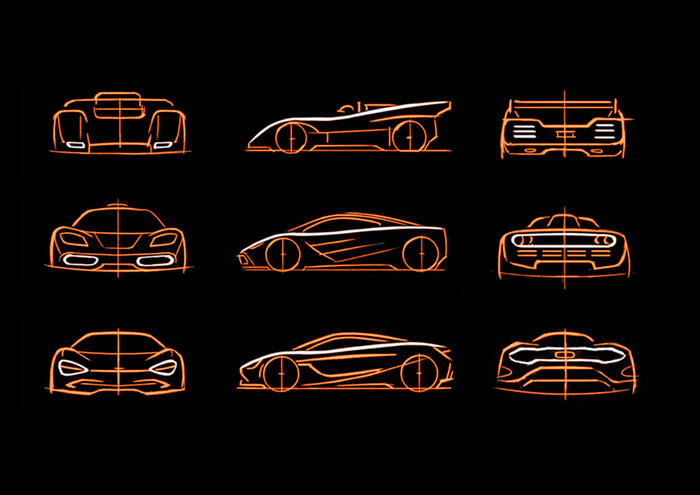For many there will be no sports car that can surpass
McLaren F1
, although now the father of the beast is closer to proving them wrong: through his own company, engineer
Gordon Murray
, creator of that industry icon, began the series production of the new T.50, a supercar that, at least in advance, has all the credentials to
become the great and long-awaited successor to the throne.
Gordon Murray and his T.50.
Gordon Murray Automotive
(GMA) is the name of the firm of the legendary British engineer that will bring to light this three-seater, which is immediately reminiscent of F1 from an aesthetic point of view, but which manages to update some of its basic concepts to be an even lighter and more aerodynamic.
At 4.38 meters long and 1.17 meters high, it weighs just 957 kilos thanks to its monocoque chassis and carbon fiber bodywork.
The number is impressive, especially when combined with the huge naturally aspirated V12 engine designed by Cosworth especially for the occasion.
Located in the central rear position, it is a
3.9-litre engine that, associated with a sixth-grade Xtrac manual gearbox, reaches 673 hp at 11,500 rpm
and a maximum torque of 467 Nm at 9,000 rpm.
The successor to the F1: GMA T.50.
This gives the GMA T.50 a weight/power ratio of 1.44 kg per CV, a more than positive number, but which, according to Murray himself, could be even better: thanks to the effect of the roof air intake, the engineer estimates that the car
could well be even closer to 700 hp.
But in addition, this is a lightweight engine –built mainly in high-resistance aluminum, on the scale it only weighs 178 kg– and with a peculiarity: even though it is still a high-performance sports car, like 71% of its torque It is already available at 2,500 rpm, it is a car that can be used without major problems in daily life.
Gordon Murray next to the T.50.
As regards the passenger compartment, and as in F1,
the driver's seat is located in the center of the vehicle,
taking center stage with a minimalist interior, focused on ergonomics and comfort for those behind the wheel.
In that sense, the driving experience is the absolute priority of the GMA T.50;
and for this reason, for example, it does not have a touchscreen infotainment system: instead, they opted for an old-school and distraction-free alternative, composed exclusively of a high-quality sound system - although it can be integrated into a smartphone via Bluetooth.
T.50 Niki Lauda.
Although GMA talks about the production of the T.50 as a serial process, the truth is that it is
an entirely handmade work.
GMA will finally begin to manufacture 100 units of the T.50, plus another 25 of an even more radical version,
named T.50s Niki Lauda
, in homage to the Austrian three-time Formula 1 champion, even more focused on the track than the base model from its 739 CV.
T.50 Niki Lauda
So much performance, quality, work time and mystique, of course, have their price: at today's exchange rates,
the T.50 and T.50s Niki Lauda were listed at 2.9 and 3.87 million dollars,
not including taxes.
In any case, if there is someone interested who has not yet contacted GMA, unfortunately they were late: all the units already have an owner waiting for them.
The stamp the former F1 in the new T.50.
The McLaren F1, a before and after
Launched in 1992,
the McLaren F1 was a revolutionary car in terms of its design and performance
, to the point that to this day it is remembered and considered one of the best super sports cars in history.
The idea was born from Murray's pen four years earlier, but far from an office and a design table:
the Briton found the inspiration while doing time at Milan airport to catch a flight
.
So he had no choice but to resort to a napkin, where he ended up laying the foundations for a vehicle with a unique appearance, without great decorations, with all the seasonings to become a timeless classic.
McLaren F1
Manufactured in a limited edition of just 106 units,
the F1 was the first production car to use a carbon fiber monocoque
, giving it a much lighter structure than the competition for an excellent power-to-weight ratio in complement with its powerful V12 engine from BMW.
McLaren F1
It is a propeller that sends a total of 627 CV to the rear axle from a six-speed box with a triple disc clutch, and which has the peculiarity of being covered in a layer of 24-carat gold to dissipate internal heat. .
With all that at its disposal, the McLaren F1
can accelerate from 0 to 100 km/h in 3.2 seconds
, and without electronic limiters it is capable of a top speed of 386 km/h;
it is the maximum figure recorded by the model, and it was achieved in March 1998, on the test track in Ehra-Lessien, Germany.
look too
The Fantastic Car is close: how is the system that will allow the driver to talk to his vehicle
The kiss of death: the tragic end of the playboy that Ferrari forced to run
The ugliest racing car in the world: the story of Le Monstre, the Cadillac that caused a stupor at the 24 Hours of Le Mans
They paid $2,400 for a Ferrari, waited 30 years to fix it, and it just sold for $18 million
The best car in the world: a German and two Koreans fight for the industry grand prix



/cloudfront-eu-central-1.images.arcpublishing.com/prisa/HPZYUWUVHPQXZXLVAJXATEN3J4.jpg)





